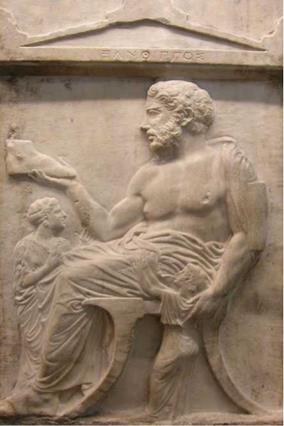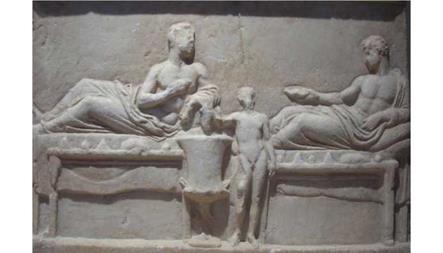Although no good-quality museum exhibits were preserved, the constructions of Greek furniture can be fairly accurately recognised based on frescoes, paintings on pottery, bas-reliefs, as well as on the basis of numerous written messages. The earliest forms of furniture works in Greece clearly take advantage of Egyptian design, but their further evolution was directed in its own original forms, reaching
peak development in the fifth century B. C. Greek artisans perfectly mastered the technology of bending and turning wood, gluing and veneering, as well as finishing wood surfaces with varnish and polychrome. They also expertly used the technique of joining elements using different connectors and glue. They knew of mortise and tenon joints, dowelled and dovetail joints, as well as frame constructions and weaved seats. They commonly used box wood, yew wood, walnut wood and ebony wood (Gostwicka 1986). In Greece, many new, original structural forms of furniture were created, especially chairs and stools. They were ascribed separate, distinctive names, which include: diphros, i. e. a small and lightweight stool, diphros okladias a type of folding stool consisting of a large number of elements under the seat, klismos, klinter or klisja is a lightweight chair with a backrest and legs that are characteristically bent forward and backward, intended mainly for women, kathedra or thronos represented by a heavy chair with a backrest, designed for men, having insignia showing their authority and family or social position.
 |
A diphros stool was relatively low, without a backrest, with straight, turned legs in the shape of a mace, usually placed perpendicular to the ground (Fig. 1.13).
The seats of these stools were most often made of a strap weave, leather or fabric. A folding stool with crossed legs was called a diphros okladias, i. e. a folding diphros. Due to the mobility of the construction, the piece of furniture was made of metal or wood.
A klismos-type chair was made from wooden curved slats obtained by both plastic working and bending wood, as well as cutting elements from trees of a large, naturally shaped curve. There are also facts known that the Greeks joined the boughs and branches of trees, fixing them to the ground with anchors, in this way forcing the desired curvature for the planned construction of furniture. The bending of legs of klisja was also important for construction, since it increased the sections of the legs in the case part, enabling technical bonding using mortise and tenon joints (Fig. 1.14).
 |
 |
The throne was usually richly decorated with animal or human figures. In many cases, the Greek throne was similar to the ones manufactured in Egypt and Assyria.
 |
 |
In particular, the structures of footrests and armrests are characteristic. However, they are distinguished by the impressive height of the backrest and rolling technology used in shaping almost every part of the piece of furniture (Fig. 1.15). The thrones were placed in public places, temples, stadiums and theatres; they were made of marble and always richly decorated by Greek ornamentation.
The ancient Greeks, like the Persians, did not have tables of a function and purpose as we know today. Commonly only feast tables were used, set by the beds and reaching the height of the bed (Fig. 1.16). An exception was sacrificial, column tables, with a wide worktop and height adjusted to a standing person.
Greek artisans paid particular attention to furniture for lying down on. They were made from wood decorated with precious veneers, inlay, incrusted with precious metals or ivory. Wealthy Greeks had beds lined with soft leathers, cloths and woollen fabrics, on which linen sheets were placed. Pillows and mattresses filled with wool or feathers were used.
|
Fig. 1.16 Beds and feast table. Chalkidiki, around 380 B. C. (Archaeological Museum in Thessaloniki) |




